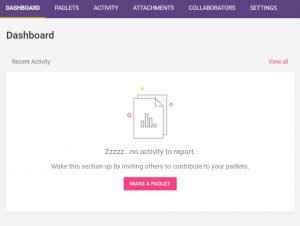Padlet: An Easy to Use Online Collaboration Tool for Multimedia Sharing
Padlet is a very user-friendly canvas or digital bulletin board that allows people to collaborate and insert anything (images, videos, documents, text) via drag and drop. This tool is very flexible and can be used creatively in a classroom context in many ways.
Equitable Participation
Despite the recent trend in online learning towards personalization and competency-based learning, there is inherent value in learning from others. While this can be accomplished in the traditional brick-and-mortar classroom without technology, student participation is typically not even. Some students like to answer every question while others do not want to actively participate. Purposeful technology use can help to alleviate the problem of uneven student engagement in a physical classroom. When education is moved to the online environment, this intentional focus on connecting students to each other and the teacher is critical. Padlet is a tool that creates a student-centered learning environment that prompts participation and articulation of student understanding. Padlet is very intuitive to use and is functional across multiple devices. Flipping the classroom is only as powerful as the experience for students. Padlet strengthens this experience.
Applying Theory to Practice
The design of the Padlet will vary based on the learning theory used. It is, by nature, a social learning tool focused on students constructing their own knowledge. Digging a little deeper, a prompt that forces students to experience uncomfortable cognitive dissonance is feasible through constructive argumentation. Connectivism and the associated social network analysis is inherent through Padlet design features. The application of learning theories is as varied as the imagination of the classroom in which Padlet is used.
There are five different styles of Padlet. They can range from a Pinterest style to a poll to a class debate. The tool is focused exclusively on fostering a shared sense of ownership, and subsequently, participation in the course. This social learning focus extends to the instructor through finding collaborators and model Padlets.
Fully Utilizing the Tool
With teaching, grading, communicating with parents, and volunteering teachers frequently have little spare time to investigate new teaching techniques. Sometimes, this is encountered through professional development. However, it is hard to integrate these technologies into everyday teaching practices. When the tool has a low learning curve and the ability to try without financial repercussions it becomes more attractive to teachers. To observe the tool being used check out our guide over at EdTechGuides.
Padlet is free to use. However, if you want to use Padlet Backpack, it provides an additional layer of customization and privacy for your classroom. The Padlet is constantly saved and has availability in 29 languages. There are different levels of access based on the stakeholder role. Padlet is able to work with virtually any file type or embedding directly from various apps. The home page will have your dashboard, Padlets, activity, attachments, collaborators, and settings.
Dashboard: This is your home page. At this page, you will see any recent Padlets and contributions to those Padlets.
Padlets: This page lists all of the Padlets you have created. This is where you select those five different Padlet types. These types allow for customization and the application of different theories of learning.
Activity: Recent activity will show here in greater detail than on the dashboard.
Attachments: If there is any attachment being used in a Padlet, this is where it can be uploaded and shared.
Collaborators: Using this feature, teachers can find both local and distant collaborators with which to create or build upon existing Padlets.
Settings: Allows users to choose their preferences and reset their username and password. This is also where you can control overall privacy settings.





